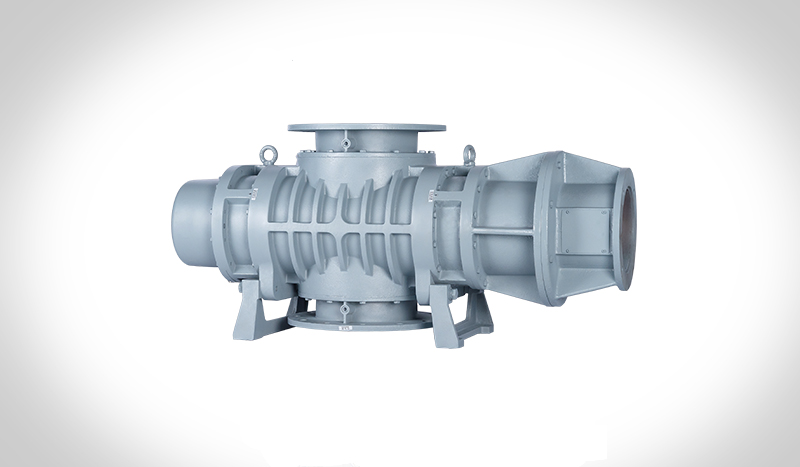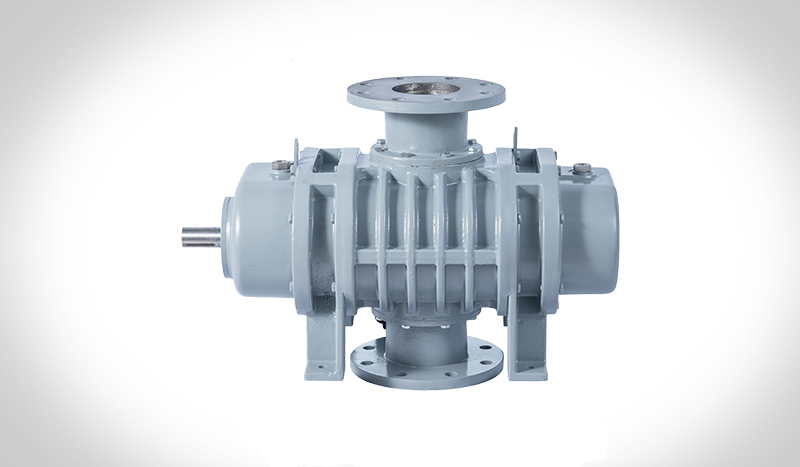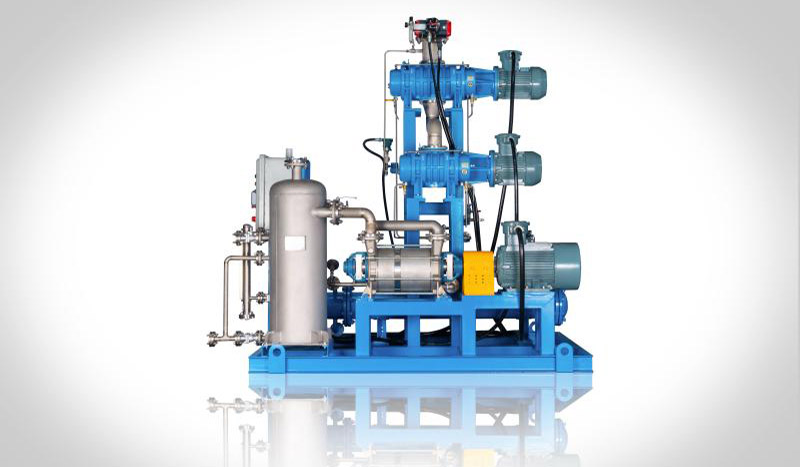Knowledge
Analysis of Failure Causes of Mechanical Seals from Failure Modes
By analyzing the causes of failure, the technical level of applied mechanical seals can be improved. Improvements in the design of the structure are to a large extent the result of failure analysis. To be as accurate as possible in analyzing failures sometimes takes time and even requires the use of specialized testing techniques.
1. Damage to endface materials by thermal loads
Notching on one or both end faces, a phenomenon that indicates that the two end faces are separated by too large a distance, and when the two end faces are tightened with force, a gap is created. A common cause of endface separation is the rapid evaporation of the medium. For example, in water, especially in hot water systems or liquids containing condensate, the water expands as it evaporates, thus separating the two end faces. Pump cavitation combined with blockage of the seal may also be the cause of a seal face gap. In this case, it is not caused by vibration or coupling misalignment, as this is not sufficient to cause the end face to gap.
Reducing the end face temperature is a common method to prevent end face damage caused by rapid evaporation of the media. Also, it is advantageous to use material grouping with good thermal conductivity, such as using nickel-based carbide with copper-impregnated graphite. In addition, the use of balanced mechanical seals, or the use of special gland from the external injection of liquid cooling, or direct cooling of the cavity seal, etc., to reduce the temperature of the seal end face are very effective.
Failure of the mechanical seal, the friction side of the face often leaves a very fine radial crack, or a radial crack with blister marks, or even cracking. This is caused by the seal overheating, especially ceramic, carbide sealing surface is prone to this type of damage. Poor lubrication, overload, high operating temperature, high linear speed, improper combination of paired materials, any one of these factors, or the superposition of several factors, can produce excessive frictional heat, if the frictional heat can not be dissipated in a timely manner, it will produce thermal cracking. These fine cracks are like cutting edges, cutting carbon graphite or other pairing materials, resulting in excessive wear and Kor leakage. To solve the seal overheating problem, in addition to changing the balance coefficient of the end face and reducing the load, you can also use static seals and add a guide sleeve to force the cooling cycle fluid to the sealing surface, or open a hydrodynamic groove on the seal end face to solve.
Many tiny hot spots and isolated discolored areas on the friction end face indicate that the seal is distorted under high pressure and thermal influence. For thermal distortion of the end face, the finite element method should be used to calculate the analysis and improve the design of the seal ring.
The seal ring with surface sprayed hard material, either sprayed ceramic or carbide, has the possibility of scaling or peeling off its face under thermal load on the base material. The occurrence of this phenomenon indicates that the seal appears to be over dry friction. To eliminate
To eliminate this phenomenon, first of all, we should check whether the lubrication and cooling of the seal are sufficient, whether the cooling system is blocked, whether the operation is proper, and take corresponding countermeasures according to the actual situation.
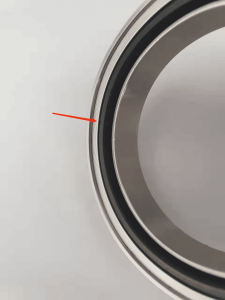
2. According to the wear marks to analyze the cause of failure
Wear marks can reflect the movement and wear of the moving parts. Each wear trace can provide useful clues for fault analysis. For example, the wear traces of the friction pair are even and normal, and the parts fit well, which means the machine has good coaxiality. If leakage still occurs on the seal end face, it may not be caused by a problem with the seal itself. For example, the wear marks on the end face of the metal bellows mechanical seal are uniform and normal, and the leakage is constant, which means that the leakage does not occur between the two end faces, but may occur on other parts, such as the static seal of the fixed bellows.
When there is too wide wear on the end face, it indicates poor coaxiality of the machine. Every revolution of the rotating shaft the seal has to make axial displacement and radial oscillation, obviously in every rotation the seal end face tends to produce slight separation and leakage. Take centrifugal pump as an example, the causes of excessive wear are: coupling misalignment, pump shaft bending, pump shaft deflection, low shaft accuracy, excessive pipe tension, vibration, etc.
Causes of vibration and cavitation, wheezing, water hammer impact, media flow imbalance, etc.. But the coupling is poorly aligned, the bearing running accuracy caused by poor vibration in most cases.
When installing the coupling, the accuracy of the centerline position of the two shafts should be measured, usually with a percentage table and a stopper, and the deviation of the outer circle of the two couplings and the deviation of the end gap should be controlled within the limit.
For the vibration caused by the hydraulic characteristics, its effective remedy is to control the pump displacement below the design value and reduce the cavitation phenomenon of the pump.
If the width of the wear marks is less than the width of the narrow ring surface, it means that the seal is under excessive pressure and the seal surface is deformed. In this regard, the seal structure should be set up from the seal to solve the problem, the use of high pressure can withstand the seal structure.
After a period of operation, if the friction surface of the mechanical seal does not have wear marks, it indicates that the seal is leaking at the beginning of use, and the leaking medium is oxidized and deposited in the vicinity of the compensation ring seal, which hinders the compensation ring to compensate for displacement. This situation is the cause of leakage. High temperature fluids with high viscosity are prone to this condition if they are constantly leaking.
In the case of rubber bellows seals, if there are no signs of wear on the end surfaces of the friction pair, this indicates that the sealing surfaces may have been pressed together and there is no relative rotation between the friction pairs, but rather the rubber bellows rotates relative to the shaft. If this happens, the spring will wear, as well as the stationary and rotating parts.
Sometimes, the rotating ring does not rotate with respect to the stationary ring, but rotates with respect to the stationary ring gland, and in this case, the end surfaces of the friction pair do not produce wear marks. The reason for this may be that the anti-rotation pin is broken, or that the bore of the static ring gland is smaller than the outer diameter of the seal and is not installed in place.
A light spot on the seal end face without wear marks indicates that the end face has been deformed by a large warpage. This is due to excessive fluid pressure, poor seal ring stiffness, and poor installation, etc. Externally mounted mechanical seal, if the clamped non-compensating ring is fixed with only two bolts and the static ring gland does not have sufficient thickness, or the positioning end face is not flat, this phenomenon will also occur.
The hard ring end surface appears deeper grooves (ring pattern, shaped like a dense grain record). The cause is mainly poor coupling alignment of the pump, or poor tracking of the seal. When vibration causes the seal endface separation, there is a larger particle material invasion between the two, if the particles are embedded in the softer carbon graphite seal ring endface, the soft ring grinds the hard endface like a grinding wheel, causing excessive wear of the hard endface. If the endface separation is caused by vibration, then the drive parts such as drive pins are bound to show abnormal wear marks as well.
Mechanical seal working in granular media, for materials are used hard end face, which is an effective way to solve the seal end face appears deep groove. For example, carbide and cemented carbide or with silicon carbide group pair is the best. Because the particles cannot be embedded in either end face, but are ground and passed between the two end faces.
Abrasion marks on the outer surface of the metal sleeve may be caused by solid particles entering the sleeve, which interfere with the seal’s ability to follow; it may also be caused by shaft deflection and large deviation of coaxiality between the shaft and the seal cavity.
3.The principles and methods of seal failure analysis
For each set of mechanical seals, regardless of the cause of failure, should be a detailed analysis of the study, and record the relevant data. After the seal is damaged, not limited to the damaged parts to find the cause of failure. The disassembled mechanical seal should also be properly collected and cleaned; placed separately according to the static and rotating parts and labeled for inspection and recording.
Inspection procedures are: first, to clarify the impact of damaged seals on the sealing performance, and then seal rings, transmission parts, loading elastic components, auxiliary seals, anti-rotation mechanism, fastening screws, etc. carefully checked for signs of wear. Auxiliary parts, such as gland, bushings, sealing chamber and sealing system should also be thoroughly inspected. In addition, the operating conditions of the equipment and previous seal failures should be understood. Based on this, a comprehensive analysis will identify the root cause of the failure.
4. The danger of corrosion on the seals
Chemical corrosion and electrochemical corrosion is a serious threat to the service life of mechanical seals. The causes of corrosion are complex, here only on the most common mechanical seals corrosion form and the most influential factors for analysis.
1). comprehensive corrosion and local corrosion
Comprehensive corrosion, that is, the surface of the parts in contact with the media to produce uniform corrosion, characterized by a reduction in the weight of the parts, and even all will be corroded, lose strength, reduce hardness. Such as with 1Cr18Ni9Ti stainless steel made of multi-spring, used in dilute sulfuric acid will appear in this case.
Local corrosion, you can simply use the parts of the etched spots, etched holes to determine. Local corrosion is the surface layer of the part becomes loose and porous, easy to peel off, and lose wear strength. Local corrosion is a multi-phase alloy in a phase or a single-phase solid solution of an element, the corrosion form of selective dissolution by the medium. For example, when cobalt-based cemented carbide is used in high-temperature strong alkali, the bonding phase metal cobalt is easily corroded, and the hard phase tungsten carbide skeleton loses strength and produces grain flaking under the action of mechanical force. Another example is that the reaction sintered silicon carbide, because the free silicon is corroded and the surface shows pockmark (when pH>10).
Corrosion has a significant impact on the performance of seals.
The impact of corrosion on the performance of seals is significant. Since seals are smaller and more precise than the host parts, they are usually made of more corrosion resistant materials than the host. For seals in direct contact with the media, although the data in the relevant corrosion manuals can be consulted to select the appropriate material, but these data may not be consistent with the conditions of use in the mechanical seal system, because they are mostly static conditions of a single media corrosion data, while the media in the process is a mixture of a variety of media. Experience shows that pressure, temperature and sliding speed can make corrosion accelerated. The corrosion rate of the seal with the temperature increase is exponential law.
When handling highly corrosive fluids, the use of external or double-ended seals minimizes the effect of corrosion on the seal because it has the fewest number of parts in contact with the process fluid. This is also one of the most important principles in the selection of seal structure under strong corrosive conditions.
2).Stress corrosion
Stress corrosion is the corrosion of metal materials in a corrosive environment under stress. Whether it is external load or residual stress, corrosion will increase. Prone to stress corrosion of materials is austenitic stainless steel, copper alloys, etc.. The process of stress corrosion is generally the formation of selective corrosion grooves on the metal surface, continuing to produce local corrosion, and finally under the action of stress, from the bottom of the groove cracking. A typical example is the drive sleeve of type 104 mechanical seal, which is made of 1Cr18Ni9Ti. When used on ammonia water pumps, the drive earring of the drive sleeve is most prone to stress corrosion cracking and damage to the earring. For this reason, the concave earring will be changed to a solid convex ear, which can prevent this stress corrosion.
3).Abrasion
High-speed movement between the seal and the fluid, resulting in micro-convexity on the contact surface. When the fluid is corrosive medium, it will accelerate the chemical reaction on the contact surface of the seal, which is sometimes favorable and sometimes harmful. If the formed oxide layer is destroyed, i.e. corrosion occurs. The destruction of materials caused by the alternating action of wear and abrasion is called abrasion. Usually abrasion on the mechanical seal of non-major components such as spring seat, push ring, ring seat and other hazards not yet quickly reflect the change in seal performance, but is one of the main forms of frictional failure. For this reason, in strong corrosive media, the friction should be used for good corrosion resistance materials, such as the use of 99.5% of high-purity alumina ceramics, or does not contain free silicon hot pressed sintered silicon carbide, etc.
4). Gap corrosion
When the medium is between metal and metal or non-metallic components, there is a very small gap, because the medium is stagnant state, will cause the gap within the metal corrosion acceleration, this corrosion form is called gap corrosion. For example, between the mechanical seal spring seat and shaft, between the compensation ring auxiliary seal and shaft (of course, there is also micro-wear) out of the groove or corrosion point is a typical example. The reason for this is because the seam media in the stagnant state, making it difficult to participate in the corrosion reaction of the material to the seam, and the seam of the corrosion products and difficult to diffuse outward, resulting in the seam of the media with the corrosion process, in the composition of the concentration, pH, etc. and the overall media to produce great differences, resulting in the seam of the metal surface corrosion intensified. Gap corrosion is very harmful to the sealing performance, the seal and the corner shaft groove, will lead to the compensation ring can not be axial displacement, loss of tracking, so that the end surface separation and leakage. For clearance corrosion, usually can be mitigated by the correct selection of materials and reasonable structural design. Such as the use of materials with good resistance to gap corrosion, in the structural design should be as far as possible to avoid the formation of gaps and accumulation of liquid dead zone; the use of self-flushing mode of circulation, so that the media in the seal cavity in a constant state of replacement and flow, to prevent changes in the concentration of media components, long-term disuse of the machine pump, the accumulation of liquid should be emptied in a timely manner, etc., in the structure to completely eliminate the gap is not possible, therefore, the general use of protective sleeve, in its seal installation parts can be sprayed corrosion-resistant materials to prevent.
5).Electrochemical corrosion
In fact, mechanical seals of various forms of corrosion, more or less with electrochemical corrosion. In terms of mechanical seal friction vice, often subject to the hazards of electrochemical corrosion, because the friction vice group commonly used in different materials, when they are in the electrolyte solution, due to the inherent potential of the material is different, the contact will appear between the different materials of the electric coupling effect, that is, a material corrosion will be promoted, another material corrosion will be inhibited. For example, copper and nickel-chromium steel pairs, used in oxidizing media, nickel-chromium steel ionization decomposition. Salt water, seawater, dilute hydrochloric acid, dilute sulfuric acid, etc. are typical electrolyte solutions. Seals are susceptible to electrochemical corrosion, thus it is best to choose materials with similar potential or ceramic and filled glass fiber PTFE group.
5. Failure of rubber seals
Mechanical seals with auxiliary seals, synthetic rubber 0-shaped ring more. About 30% of the mechanical seal failure is caused by the failure of the 0-shaped ring. Its failure form is manifested as follows.
1). Aging
High temperature and chemical corrosion is usually the main reason for the hardening and cracking of rubber products. Rubber aging
The aging of rubber is manifested by hardening of rubber, reduction of strength and elasticity, and in severe cases, cracking, resulting in loss of sealing performance.
Rubber aging can occur in storage, long-term exposure to sunlight, or contact with ozone, or too long storage time. Overheating can cause decomposition of rubber components and even carbonization, and in high-temperature fluids, there is a risk that the rubber will continue to vulcanize and eventually lose its elasticity and leak. So it is necessary to know the safe use temperature of each kind of synthetic rubber.
2).Permanent deformation
Permanent deformation of rubber seals is usually more serious than other materials. For example, rubber O-rings become square in use. When the seal is exposed to high temperature for a long time, it becomes the same cross-sectional shape as the groove, and when the temperature remains constant, it can still play a sealing role; however, when the temperature decreases, the seal shrinks quickly, forming a leakage channel and generating leaks. Therefore, attention should be paid to the use of various rubber temperature limit, should be avoided for a long time in the limit of temperature use. If you can not change the operating conditions of the seal, the structure should be improved to reduce the temperature of the rubber material adverse effects. For example, as far as possible, the use of larger cross-sectional rubber O-ring, O-ring to be far from the friction side of the end face, appropriate to improve the hardness of the O-ring, the use of groove assembly structure (without pushing the ring extrusion type structure, do not make the spring force for the O-ring) and so on.
3).Solution deformation
Synthetic rubber in some media will be swollen, sticky or dissolved and other phenomena. Therefore, according to the nature of the working medium, the use of relevant information on the chart to select the appropriate material. If the components of the working medium conveyed are not very clear, the impregnation test should be conducted to guide the reasonable selection of materials. Some mixed solutions may be clouded with a variety of synthetic rubber, which requires the use of polytetrafluoroethylene as a seal.
4).Twisting and extrusion damage
Compensation ring rectangular groove in the rubber O-ring, in the assembly or use of twisted twist. The reasons are: O-ring hardness and low cross-sectional diameter is too small, or uneven diameter of the circular cross-section, fluctuations in working pressure, shock vibration, and small internal pressure and poor lubrication, etc. can make O-ring twist. Most of the distorted parts occur in the middle of the O-ring. When the distortion is serious, the cross-section will become thin, while there will be leakage and increased friction. Prevent O-ring distortion methods are as follows.
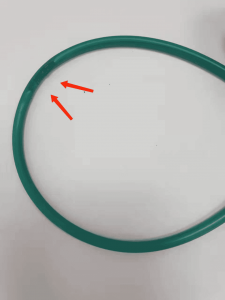
① O-ring should be greased in the groove before installation, and the shaft should be polished to ensure that the O-ring rolls freely.
② Compression should be taken as much as possible to take the appropriate value, appropriate to relax the width of the slot so that the O-ring can be rolled in the slot.
③In the case of several cross-sectional options, priority should be given to the larger cross-sectional O-ring.
④ Change to other seals that do not distort, such as X-shaped cross-section seals.
O-ring extrusion, that is, the role of high pressure O-ring in the gap will produce stress concentration, when the stress reaches a certain level, O-ring will form a flying edge embedded in the gap, resulting in O-ring wear or gnawing, premature failure of the seal, resulting in media from the seal leakage. Obviously, the cause of extrusion is mainly related to the pressure and gap of the sealing part, and the hardness of the O-ring material. Reducing the gap can prevent extrusion, but will reduce the seal ring’s floating follow characteristics. Therefore, under high pressure conditions. The measure to prevent extrusion of rubber O-rings is to install retaining rings in the O-ring grooves. Especially for small cross-section of the O-ring must be added PTFE or polyimide material retaining ring.
6.Wear, fracture or corrosion of the seal driving parts
Drive pins, drive screws, flanges, forks and even a single large spring can be used to transmit torque and drive the seal rotation. Vibration or installation position is skewed, different center, etc., will make the transmission parts wear, bending or even damage. The set screws used in mechanical seals should not be made of hardened materials. When inspecting the wear, the first thing to do is to inspect the transmission connection point, you can look for wear marks on the pin, groove, flange and fork. The wear of the drive pin or drive groove is caused by the bonding-sliding action. If the two end surfaces are bonded together in a short time, the pin will be subjected to a lot of stress because the rotating ring does not rotate smoothly and the rotation will produce runout. When the opening and stopping is frequent or the force is too large, the drive pin is also easy to break, so that the seal suddenly fails. Poor lubrication will also produce bonding-sliding action.
Other reasons for transmission pin breakage are: excessive spring force; high medium pressure and the use of non-equilibrium seal or seal fluid lubrication performance is very poor, and the torque is large; transmission pin assembly tilt; single force; the choice of only consider the corrosion resistance of the friction sub-materials, without considering the performance of the group; pump cavitation phenomenon, etc..
7.Frictional heat damage
Abnormal frictional heat damage is also one of the reasons for mechanical seal failure. Shaft (or sleeve), gland, seal cavity and seals can be damaged by abnormal overheating. Frictional thermal damage can be determined by frictional marks and color. With the temperature rise metal to change color, for example, the color of stainless steel: light yellow about 370 ° C blue about 590 ° C ink about 648 ° C In some pumps, the appearance of abnormal overheating causes are: the shaft deflection too large pump throat and shaft friction, no positioning guide gland and pump shaft (or sleeve) friction, set screw loose and seal chamber friction, gland gasket slippage contact rotation ring, etc..
Abnormal friction generates a lot of heat that can completely melt the Teflon V-ring or scorch the rubber O-ring.
Causes of abnormal friction and heat: no positioning guide gland and pump shaft (or sleeve) touch; stationary ring rotation; seal cavity dirt accumulation; seal cavity and shaft is not centered, etc..
8.The failure of the spring or bellows
In use, the mechanical seal spring or metal bellows failure forms: permanent deformation, fracture, corrosion, creep or relaxation, etc.. Among them, the metal bellows to produce permanent deformation and fracture failure of the most complex factors. Most of the loaded elastic elements of mechanical seals use cylindrical compression coil springs. Therefore, here is mainly the analysis of the failure of the cylindrical compression coil spring, in principle, also applies to other springs or metal bellows.
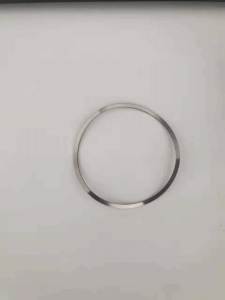
1). Permanent deformation
Spring permanent deformation is one of the main reasons for spring failure, spring permanent deformation, more than the allowable range will affect the normal work of the seal.
Permanent deformation of the spring, that is, the free height of the spring is reduced, in the case of a certain working height, the working load will be reduced. Permanent deformation is the reason for the failure of the spring is not designed and manufacturing process is not perfect. It is related to the following factors.
① Under the given conditions, the main factor affecting the permanent deformation of the spring is the working stress. In different working load conditions, the permanent deformation of the spring is different. Foreign information that the working stress of the spring should not exceed 0.3δb (tensile strength) of its material.
② The permanent deformation of the spring is related to its diameter. Seal designers often pay attention to adjust the spring diameter to meet the load requirements, little attention to the impact of the spring diameter on the permanent deformation, the result is likely to lose both. Reducing the spring diameter can reduce the permanent deformation.
③The smaller the free height of the design spring, the greater the relative permanent deformation. Tests have shown that by increasing the free height of the spring, the permanent deformation of the spring can be reduced. However, it should be noted that too large a free height can also produce bending and instability (small diameter springs).
④ The permanent deformation of the spring is related to the pitch. When the free height of the spring is constant, increasing the pitch of the spring and reducing the number of turns, it is easy to produce permanent deformation of the spring.
⑤ spring permanent deformation and spring material properties, manufacturing process, the choice of heat treatment and other factors. For the spring plant, you must strengthen the management of material properties and processing quality. The first is to strengthen the quality of incoming materials testing and proper management, and strictly prohibit unqualified materials into the production site. Select the spring processing and heat treatment process, not only to follow the general principles, but also consider the impact of permanent deformation to improve the quality of mechanical seal springs.
Spring and metal bellows permanent deformation in addition to the above factors, but also with the use of temperature, the use of temperature must be within the temperature specified in the material.
2). Fracture
Spring fracture is also one of the main forms of spring failure. According to the nature of the spring load, the working environment, the fracture form of fatigue fracture, stress corrosion fracture and overload fracture.
Spring or metal bellows fatigue fracture causes, most of them belong to improper design, material defects, poor manufacturing and poor working conditions and other factors that lead to the expansion of fatigue cracks caused by. Fatigue cracks often originate in the high stress area. Such as the inner surface of the compression spring fracture, often with the spring material axis at an angle of 45 ° direction to the outer surface and fracture, the fracture of the metal bellows often appear in the bellows valley.
Welded metal bellows, if due to manufacturing defects, such as unequal spacing, and thus there will be some waves in the larger stress, so that these waves produce early rupture. The so-called manufacturing defects, refers to the uneven spacing of the wave, the depth of the wave is not equal and the thickness of the film is not the same, etc.. When installing static metal bellows mechanical seal, there may be defects due to the gland and support point connection is tilted surface. This defect will also generate stress in the wave plate, resulting in fracture.
In many cases, resonance may occur when the frequency of the periodic expansion and contraction of the welded metal bellows is equal to the inherent frequency of the seal, resulting in a large stress and early fatigue fracture. There are two forms of vibration that can occur within a welded metal bellows seal, axial vibration and torsional vibration. Axial vibration is generated by the axial runout of the shaft, while torsional vibration is usually generated by the frictional forces between the frictional pairs. The frictional force tends to tighten around the bellows until the frictional force is less than the winding force in the bellows. Thereafter, the force releases itself. This cycle repeats itself. This torsional vibration turns into axial vibration on its own, and when the two adjacent welded balls collide with each other, the vibration weakens and the amplitude decreases, and so on.
To prevent resonance, the inherent frequency of the seal should be designed to be larger than the main vibration frequency (by changing the material, sheet thickness, number of sheets, spacing, and mounting length), or by using asymmetric waveforms and forks to transmit torque. In addition, the use of various damping methods can also eliminate vibration, such as the use of a damping sheet installed around the bellows, resulting in a slight elastic load, thus ensuring contact with the bellows, before the amplitude of the formation of the vibration is attenuated, damping sheet on the kinetic energy of the bellows export.
Under the action of medium erosion and material stress, the spring and metal bellows will fracture phenomenon, called stress corrosion fracture. Austenitic steel springs are susceptible to stress corrosion by oxides under the effect of alternating stress, for which the use of Hastelloy is recommended.
Springs and bellows working in corrosive media, in the stress region of its cross-section, due to corrosion and stress together in some weak points of the components, the first to be corroded, the formation of a crack core, with the extension of the load-bearing time, the crack slowly to subcritical expansion. When the crack reaches the critical size, its elastic element will suddenly fracture. Stress corrosion fracture and the working medium has a close relationship, such as the medium contains chlorine, bromine or fluorine, metal elastic elements prone to stress corrosion fracture. Stress corrosion fracture, mechanically speaking, is the anodic reaction, while hydrogen embrittlement fracture is mainly cathodic reaction. In most cases, hydrogen embrittlement fracture of springs, where hydrogen atoms penetrate the grain boundaries of the spring material and combine to form hydrogen molecules, results in a large stress, resulting in a brittle fracture of the spring under a low stress load. Hydrogen embrittlement fracture usually occurs in the range of 45° to 90° of bending angle. If the spring ring has become brittle clamped in a vise, clamped with pliers outreach and force bending, the spring can be easily broken into two or three segments. If the fracture is caused by other reasons, it will be found that the spring material still maintains sufficient toughness. In seawater, sulfide, sulfuric acid, sulfate, caustic soda, liquid ammonia and media containing hydrogen, the brittle fracture caused by the chemical reaction of hydrogen gas absorbed by the spring material.
Spring or bellows fracture damage in addition to the above factors, there are the following reasons.
① heat treatment defects. Due to improper heat treatment process and the material implies internal defects. Such as heat treatment caused by coarse grains of spring material, although the need to get the hardness, but in use soon deformation eventually fracture.
② tool caused by the scar. Spring manufacturing process, especially with the hook spring bend hook, often due to improper manufacturing process caused by scars and stress concentration areas, resulting in the bend hook fracture.
It can be seen that the measures to prevent fracture damage, in addition to the design of the spring according to the working conditions, select the appropriate material, determine the appropriate stress value, in the manufacturing process to take the appropriate processing methods, is also very necessary.

